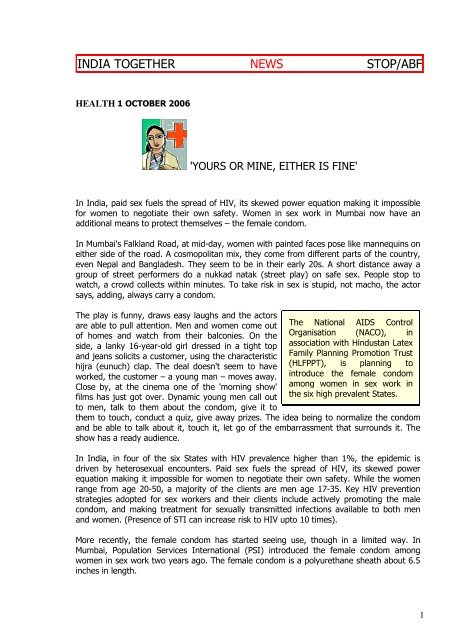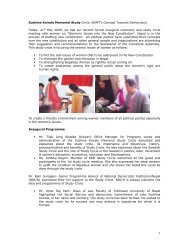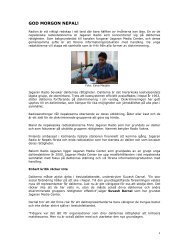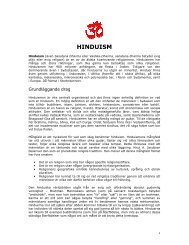INDIA TOGETHER NEWS STOP/ABF - Helsingborgsdialogen
INDIA TOGETHER NEWS STOP/ABF - Helsingborgsdialogen
INDIA TOGETHER NEWS STOP/ABF - Helsingborgsdialogen
Create successful ePaper yourself
Turn your PDF publications into a flip-book with our unique Google optimized e-Paper software.
<strong>INDIA</strong> <strong>TOGETHER</strong> <strong>NEWS</strong> <strong>STOP</strong>/<strong>ABF</strong><br />
HEALTH 1 OCTOBER 2006<br />
'YOURS OR MINE, EITHER IS FINE'<br />
In India, paid sex fuels the spread of HIV, its skewed power equation making it impossible<br />
for women to negotiate their own safety. Women in sex work in Mumbai now have an<br />
additional means to protect themselves – the female condom.<br />
In Mumbai's Falkland Road, at mid-day, women with painted faces pose like mannequins on<br />
either side of the road. A cosmopolitan mix, they come from different parts of the country,<br />
even Nepal and Bangladesh. They seem to be in their early 20s. A short distance away a<br />
group of street performers do a nukkad natak (street play) on safe sex. People stop to<br />
watch, a crowd collects within minutes. To take risk in sex is stupid, not macho, the actor<br />
says, adding, always carry a condom.<br />
The play is funny, draws easy laughs and the actors<br />
are able to pull attention. Men and women come out<br />
of homes and watch from their balconies. On the<br />
side, a lanky 16-year-old girl dressed in a tight top<br />
and jeans solicits a customer, using the characteristic<br />
hijra (eunuch) clap. The deal doesn't seem to have<br />
worked, the customer – a young man – moves away.<br />
Close by, at the cinema one of the 'morning show'<br />
films has just got over. Dynamic young men call out<br />
to men, talk to them about the condom, give it to<br />
The National AIDS Control<br />
Organisation (NACO), in<br />
association with Hindustan Latex<br />
Family Planning Promotion Trust<br />
(HLFPPT), is planning to<br />
introduce the female condom<br />
among women in sex work in<br />
the six high prevalent States.<br />
them to touch, conduct a quiz, give away prizes. The idea being to normalize the condom<br />
and be able to talk about it, touch it, let go of the embarrassment that surrounds it. The<br />
show has a ready audience.<br />
In India, in four of the six States with HIV prevalence higher than 1%, the epidemic is<br />
driven by heterosexual encounters. Paid sex fuels the spread of HIV, its skewed power<br />
equation making it impossible for women to negotiate their own safety. While the women<br />
range from age 20-50, a majority of the clients are men age 17-35. Key HIV prevention<br />
strategies adopted for sex workers and their clients include actively promoting the male<br />
condom, and making treatment for sexually transmitted infections available to both men<br />
and women. (Presence of STI can increase risk to HIV upto 10 times).<br />
More recently, the female condom has started seeing use, though in a limited way. In<br />
Mumbai, Population Services International (PSI) introduced the female condom among<br />
women in sex work two years ago. The female condom is a polyurethane sheath about 6.5<br />
inches in length.<br />
1
It lines the vagina entirely and helps to prevent pregnancy and sexually transmitted<br />
infections (STIs) including HIV. Each end of the condom has a flexible ring. At the closed<br />
end of the sheath, the flexible ring is inserted into the vagina to hold the female condom in<br />
place. For women in sex work who may find it difficult to negotiate condom use with clients<br />
and partners, pilot interventions are exploring if the female condom can be used as an<br />
alternative. The intervention presently reaches out to over 6,000 women in redlight areas in<br />
the heart of Mumbai as well as suburbs Vashi and Bhiwandi.<br />
The National AIDS Control Organisation (NACO), in association with Hindustan Latex Family<br />
Planning Promotion Trust (HLFPPT), is planning to introduce the female condom among<br />
women in sex work in the six high prevalent states. It has ordered five lakh pieces from the<br />
London-based manufacturer Female Health Company. These will be made available through<br />
NGOs working in select sex work locations. The product which is being bought from the<br />
company at a cost of Rs.45 will be social marketed at Rs 5 to the consumer. Says Dr<br />
Sanjeev Kumar, HLFPPT: "We know from evidence that despite active promotion of the<br />
male condom it is still not being used in 20-30 per cent encounters. The female condom,<br />
we hope, will cover this gap." He emphasises that the female condom should not be seen<br />
as a replacement for the male condom but as a women-controlled preventive device to<br />
bridge the gaps.<br />
It is a tough world out there in Mumbai's redlight areas: Competition is stiff and businees is<br />
low. The women say police raids have increased in the last few months. Bhiwandi remains a<br />
communally volatile area while Vashi has its mafia and gang wars. In the suburbs, the<br />
communities are largely homogenous. The devadasi women from Andhra Pradesh and<br />
Karnataka live here, many of them are older women. In contrast, life in Mumbai's redlight<br />
areas is as cruel and aggressive as it can get: Fierce competition, uncertain earnings,<br />
pressure to send money back home in the village. To top it all, the worry about contracting<br />
HIV.<br />
Mallika, a 40-something devadasi from Karnataka who has lived in Kamathipura over 20<br />
years says, "Women are afraid of STI and HIV yet don't want to lose out on income. Even<br />
though condom use among men has increased over the years, still one in ten men refuse<br />
the condom." She says she uses the female condom with men who refuse to use the<br />
condom. Munni, 26, a cheerful and comely woman from Bihar working out of Kamathipura<br />
insists safety is of prime importance.<br />
She says she uses the female condom with her regular partner or 'husband', cleverly telling<br />
him it is a good contraceptive. 'Married' to a Bengali man, the couple dote on their 4-yearold<br />
perky son. "The truth is we cannot tell if either of us is infected, yet I cannot ask him to<br />
use a condom," she says. Munni does not see the need to test unless there are obvious<br />
symptoms of infection, but is conscious not to take risks even in a trusted relationship. She<br />
insists on the condom in every encounter and admits that using the condom in a marriage<br />
is difficult.<br />
The women are aware of the harsh reality of HIV. Ensuring personal safety against the<br />
professional hazards remains a daily challenge. Munni says a middle-aged client who is a<br />
regular, insists on unprotected sex and gives her Rs 2,000 each time for it. "I know that<br />
good health is more important than money, so I use the female condom. He does not come<br />
to know – he thinks it's unprotected, I know I am safe. Why turn away a well-paying<br />
client," she asks.<br />
For women like Munni and Mallika, the female condom has helped ensure safety on their<br />
own terms. Older women like Mallika say competition is so stiff, they find it difficult to insist<br />
the client use a condom.<br />
2
Be it Mumbai's Kamathipura, or Kolkata's Songachi, or the devadasi community in Bagalkot,<br />
Karnataka, women in sex work say that with AIDS awareness condom use has gone up in<br />
the last few years. However, it remains low with drunken and abusive clients. Those<br />
working in the field add condom use is also low with regular partners. The women feel<br />
condom use is inappropriate in a trusted relationship -- intimacy implies trust, trust implies<br />
no condom. Interpersonal communicators however say that women don't see themselves at<br />
risk from the regular partner and end up getting infected through them.<br />
They tell the women they must use the condom with their regular partner while they are in<br />
sex work; once they leave sex work and are sure neither is infected, they can stop using<br />
the condom if they so wish. Saira, a 20-something interpersonal communicator with PSI in<br />
Mumbai says that interestingly, discussions with men reveal that not just the men, women<br />
also don't want to use the condom in a 'marriage'.<br />
Programme managers see this glaring gap in condom use as worrisome. Arundati<br />
Muralidharan, PSI, says, "We believe the female condom can help bridge this gap." The<br />
response so far has been mixed. At present, PSI is social marketing it at Rs 2. Those buying<br />
the female condom are in the age group of 25-30; they say it is very useful and customers<br />
approve of it. There are others who say it is a good product but why use it when the male<br />
condom is so much simpler and available for free. Some give the choice to the customer –<br />
asking him to choose between the male and female condoms. Others refuse to entertain<br />
any discussion on the female condom at all. It's unwieldy size and shape, fear of initial<br />
discomfort and anxiety about partner response have left many women closed to the idea.<br />
Programme officers say two years down the line, sales are low, but that is not the main<br />
concern. "We want greater number of women to try the free samples we are distributing.<br />
Breaking into this difficult terrain has been challenging, even frustrating, and yet there has<br />
been the odd success story that told us it was important to keep at it. The male condom has<br />
taken 20 years to normalise, we had no illusions that this would be readily accepted," says<br />
Arundati.<br />
Communication materials developed by the interpersonal communicators catch a slice of life<br />
from the women's experience. For example, the Seeta and Geeta story: Seeta is in her early<br />
20s, madly in love with a client, dreams of marriage. Geeta is pragmatic, 35-year-old, one<br />
who has seen the world. Although Geeta has a partner, she realizes he will not leave his wife<br />
and children to marry her. She is aware she must secure her own future and dreams of<br />
building a house. The story goes – why are they in Mumbai? 'Everyone is here to earn<br />
money. And yet, every woman is looking for love. How did the female condom help both<br />
women to fulfil their dreams – Seeta was able to protect herself from infection while in sex<br />
work and married her boyfriend; Geeta protected herself and her partner and was able to<br />
build a house.' Says Arundati: "We know women like Seeta and Geeta exist – young,<br />
attractive, hopeful, want to secure their own future. We want to pitch the product to them."<br />
Users like Renu, 25, who moved from Kolkata's Sonagachi to Kamathipura in Mumbai last<br />
year, says she has been using the female condom for about a year. Client response has been<br />
good, with one of her 'regulars' insisting she use it each time. It has its advantages:<br />
Polyurethane is a better conductor of heat than latex, of which the male condom is made. It<br />
is well lubricated on the outside and the inside so it does not cause any abrasion. Unlike the<br />
male condom, it also protects the external genital area from STI and RTI. The women say it<br />
is particularly useful during the menstrual cycle, although it has its problems too: It needs to<br />
be held in place, inserting it and disposing it is cumbersome, it is visible. The women have<br />
devised their own ways and means to deal with these issues.<br />
3
Marketing the female condom hasn't meant that the male condom will be de-emphasised.<br />
Recognising the importance of reaching out to male clients of sex workers alongside, PSI is<br />
actively promoting the male condom through game shows and quiz programmes in the<br />
redlight areas. It is also disseminating information on the female condom. "Worldwide,<br />
research shows that introducing the female condom reduces overall incidence of unsafe<br />
sexual encounters," says Arundati. Greater awareness and discussion, increased choices,<br />
clearly results in less risky behaviour. As Dr Sanjeev Kumar, HLFPPT, puts it: "Our campaign<br />
for promoting the female condom is – 'Yours or mine, either is fine'."<br />
Meanwhile, young women in the trade like Munni and Renu who are now buying the female<br />
condom encourage other women to try this option. It certainly works for them, they say – it<br />
keeps them safe, gives them an edge over the other women in times of stiff competition.<br />
The customer is not complaining either.<br />
Sumita Thapar and Akhila Sivadas<br />
Akhila Sivadas heads the Centre for Advocacy and Research (CFAR), a non-profit media and<br />
communication research group in New Delhi. Sumita Thapar is a freelance journalist and a<br />
consultant with CFAR. She has been working and writing on HIV/AIDS.<br />
<strong>ABF</strong>-<strong>STOP</strong> Helsingborg<br />
GH<br />
4













